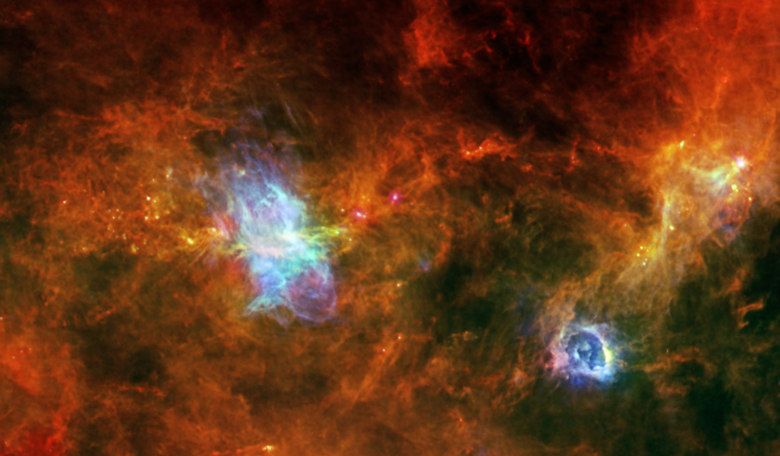Scientists studying complex organic molecules connected with the building blocks of life and which have recently been detected in a nearby star-forming region, are one step closer to unlocking how these molecules are formed in the deep recesses of space.
Complex organic molecules (COMs), from an astrophysical point of view, are molecules that have at least six or more atoms, some of which are carbon. They are of great interest to scientists as these types of molecule are expected to play an important role in prebiotic chemistry and are therefore considered the basic ingredients to explain the origin of life.
The simplest sugar glycolaldehyde (CH2OHCHO), for example, is involved in the formation of amino acids and can react with another sugar, propenal, to produce ribose. Ribose is an important component of nucleotides, and is found in ribonucleic acid (RNA). This molecule along with its cousin ethylene glycol (CH2OH)2, the simplest sugar alcohol, have both been detected in the interstellar medium (ISM); but how did they get there? Did they form in situ through gas phase reactions or were they produced via reactions on the surface of interstellar dust grains?
Using the Green Bank Telescope, the IRAM 30m millimetre radio telescope and the Submillimeter Array, a team of scientists based in Italy have analysed spectra from G31.41+0.31 – a chemically rich massive star-forming region – to ascertain just how these molecules are formed.
G31.41+0.31 (or G31 for short), which is located around 7.9 kilo parsecs from us, is considered an ideal region in which to study these complex molecules as it contains a luminous hot molecular core believed to be heated by several massive protostars. Indeed, a number of complex species have already been detected within G31, however observations have been limited to certain species and constrained to specific locations. The team in Italy have therefore expanded the search by analysing the abundances and spatial distributions in a large sample of star-forming regions to help narrow down the chemical pathways leading to the formation of COMs.
The team whose research paper is headed by V. M. Rivilla from Osservatorio Astrofisico di Arcetri, Italy, found that while both molecular species are likely to be formed by different chemical formation routes, they are both produced more effectively on dust grains rather than in the gas phase – and by a large margin.
Part of the chemical reaction to make glycolaldehyde is the joining of two HCO molecules. HCO can be found in many dusty astronomical environments from the outer layers of stars to planetary nebula. Regions such as G31 are heavily obscured by dust and it is becoming clear, that dust is a key aspect in the formation of complex molecular species in the harsh environments of space. The joining of HCO molecules on the surface of ice is also predicted to be fast.
Could these COMs then survive on grains long enough to be incorporated into larger bodies, that either become planets or cruise around the galaxy as comets/meteorites? With further research the lifecycle of COMs will help ascertain how resilient these important molecules are.
For further information on this research see; http://arxiv.org/pdf/1608.07491.pdf











